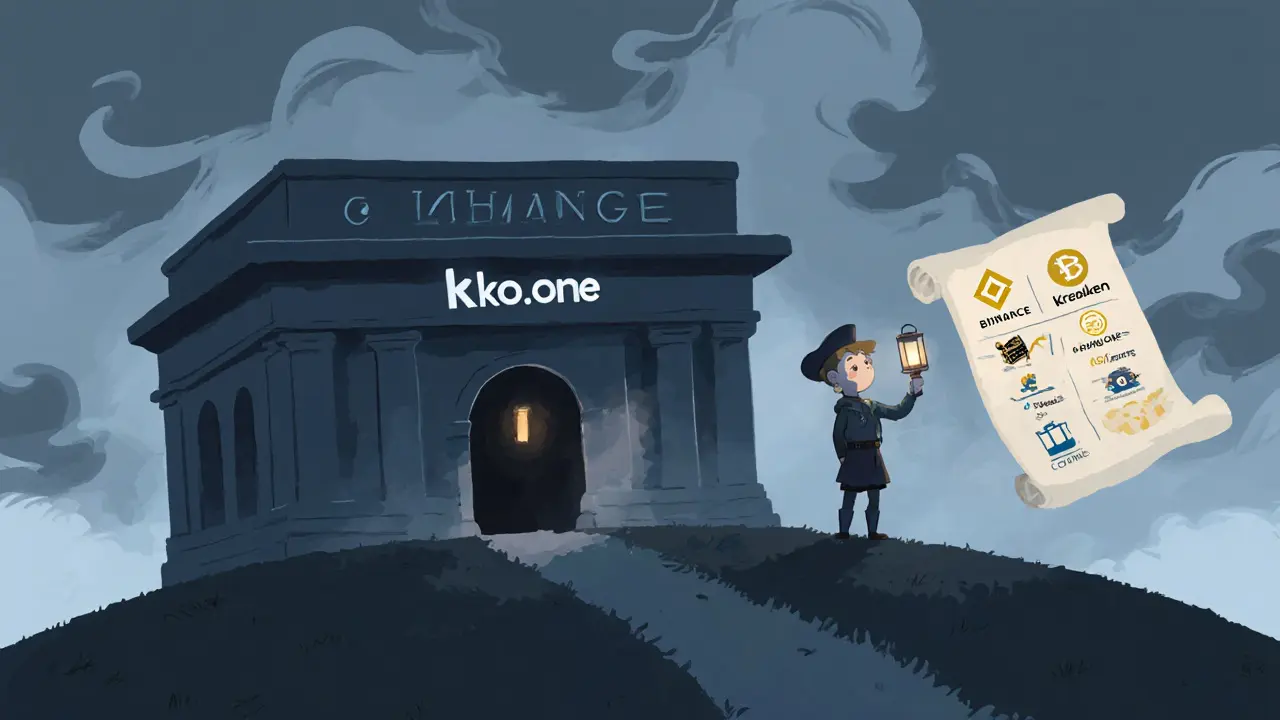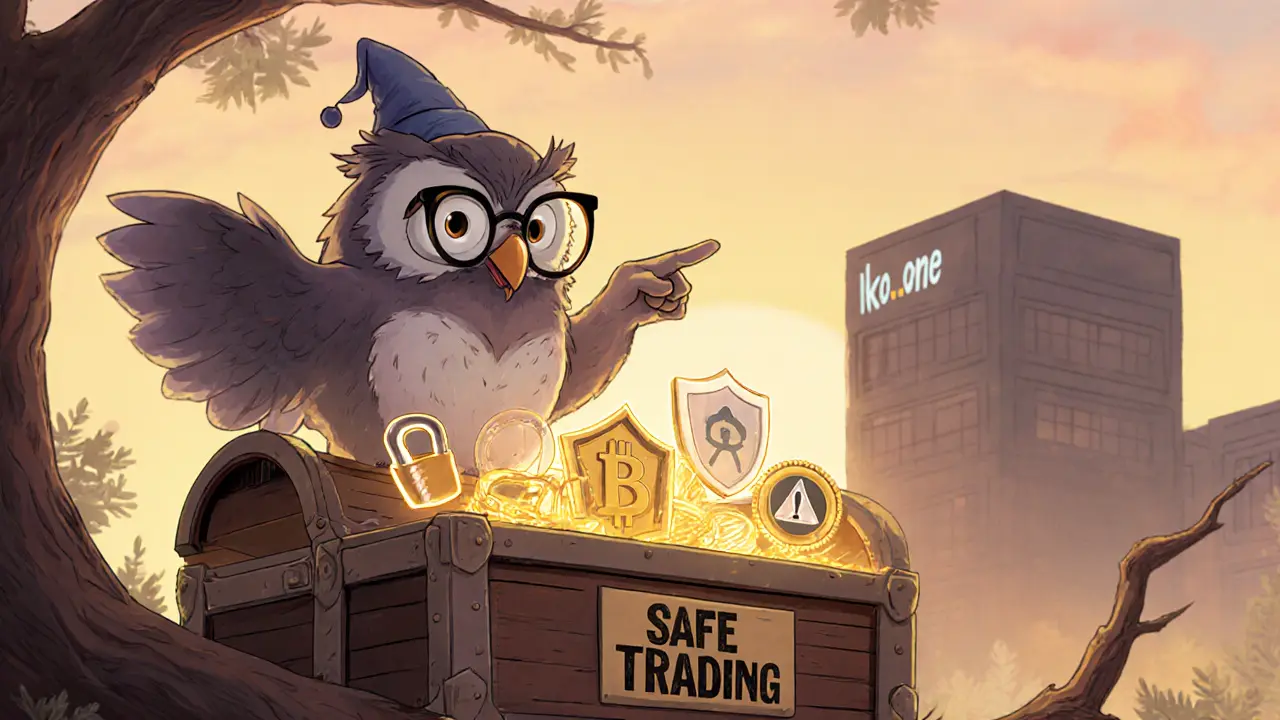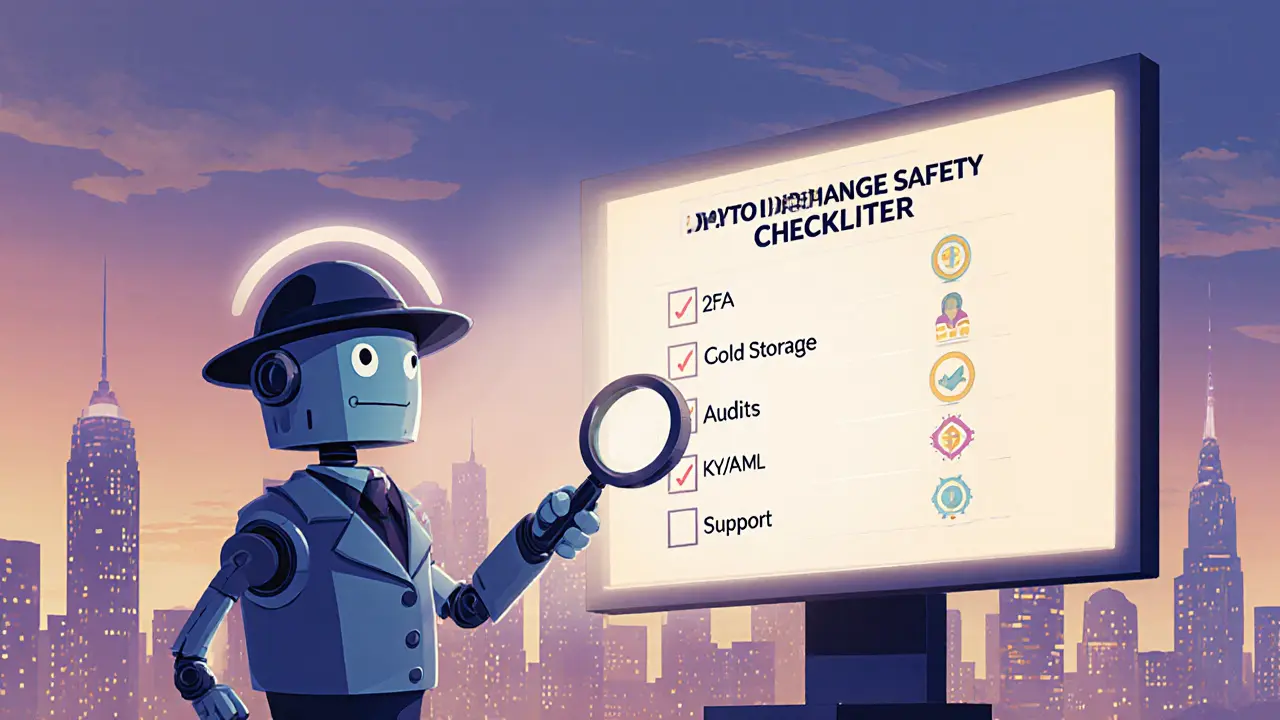Crypto Exchange Safety Checker
Exchange Evaluation Checklist
Rate the following security and compliance features for your target exchange:
Quick Take
- ko.one is barely visible in public data - no verifiable audits, fees, or user base.
- Industry‑standard security features like 2FA, cold storage, and SSL are not publicly confirmed.
- Regulatory compliance (KYC/AML) is unclear; South Korean exchanges like Coinone have clear procedures.
- For most traders, established platforms such as Binance, Kraken or Coinone are safer bets.
- Use the checklist below before depositing any funds on an unknown exchange.
When scouting a place to trade digital assets, ko.one is a cryptocurrency exchange that claims to offer spot trading, low fees and a mobile app but leaves virtually no trace in the public domain. No official blog, no audit report, and no regulatory licence can be found through reputable sources as of October2025. That lack of transparency makes the platform a high‑risk choice, especially when the crypto market still wrestles with security breaches like the 2024 DMM Bitcoin hack.
What We Could (and Couldn’t) Find About ko.one
Typical research steps - a quick WHOIS lookup, a scan of the exchange’s website, and a search for community feedback - all hit dead ends. The domain "ko.one" redirects to a generic landing page with no contact info, no terms of service, and no about‑us section. No major crypto news outlet has ever covered a launch, and the only name that surfaces is the South Korean exchange Coinone the third‑largest exchange in South Korea, known for partnerships with CertiK and Xangle. Because of this vacuum, we have to evaluate ko.one against the baseline security and compliance standards that trustworthy exchanges usually publish.
Industry‑Standard Security Checklist
Legitimate platforms normally showcase a handful of protective measures. Here’s what you should see and what ko.one is currently missing:
- Two‑Factor Authentication (2FA) an extra login code sent via authenticator app or SMS - no public confirmation from ko.one.
- Cold Storage offline wallets that keep the majority of user funds away from the internet - the exchange’s whitepaper never mentions a cold‑wallet percentage.
- SSL Encryption HTTPS with strong ciphers that protect data in transit - the landing page uses HTTPS, but we could not verify HSTS or cipher suites.
- KYC Know‑Your‑Customer checks to verify user identity - the registration flow stops after an email sign‑up; no ID upload required.
- AML Anti‑Money‑Laundering monitoring of suspicious transactions - no policy page is available.
- Bug Bounty Program rewards for external security researchers who find vulnerabilities - not listed anywhere.
By contrast, Coinone works with CertiK for code audits and Xangle for project disclosure, offering a transparent security posture. The absence of comparable proof for ko.one is a red flag.
Fee Structure & Trading Features
Without a public fee schedule, we can only rely on user screenshots circulating in obscure forums. Those screenshots suggest a maker‑taker model with 0.10% maker fees and 0.20% taker fees - numbers that are competitive on paper but unverified. No information is given about deposit/withdrawal fees, limit‑order types, margin trading, or futures contracts.
Established exchanges publish detailed charts. For example, Binance the world’s largest crypto exchange by volume, offering spot, futures, and staking lists withdrawal fees per coin, while Kraken a U.S.-based exchange known for robust security and fiat on‑ramps provides tiered fees based on 30‑day volume. ko.one’s silence on these basics makes cost‑calculation impossible before you trade.

Regulatory Landscape
South Korea’s Financial Services Commission (FSC) has been tightening oversight, demanding that exchanges obtain a licence, implement KYC/AML, and accept liability for theft. Coinone has complied with the FSC and works with regulatory‑tech firms to stay ahead of new rules. ko.one offers no licence number, no jurisdiction, and no published compliance framework. For traders in NewZealand, the Financial Markets Authority (FMA) also expects overseas platforms to be AML‑registered - a claim ko.one does not make.
User Experience & Support
A quick navigation test shows a minimalist UI, but the “Help” button leads to a dead‑end PDF that simply reads "Contact [email protected]" - an email address that bounces back. No live chat, no Telegram community, and no social media presence were found. In contrast, Binance’s 24/7 chat, Kraken’s ticket system, and Coinone’s Korean‑language hotline provide tangible assistance.
Comparison Table: ko.one vs. Popular Exchanges
| Feature | ko.one | Coinone | Binance | Kraken |
|---|---|---|---|---|
| Public security audits | None disclosed | CertiK audit (2024) | Regular third‑party audits | Annual SOC‑2 report |
| 2FA (FIDO2‑compatible) | Unverified | Yes | Yes | Yes |
| Cold storage % of funds | Undisclosed | ~95% | ~98% | ~96% |
| Fee (maker/taker) | 0.10% / 0.20% (claimed) | 0.10% / 0.15% | 0.10% / 0.10% (VIP tiers) | 0.16% / 0.26% (tiered) |
| KYC/AML compliance | Not shown | Full KYC, Korean FSC licence | Standard KYC, global licences | Full KYC, US FinCEN registration |
| Customer support | Email only (non‑responsive) | Phone + chat (Korean) | Live chat, ticket, social media | Ticket system, phone (US) |
How to Vet an Unknown Exchange - A Practical Checklist
- Verify the domain’s WHOIS details - is the registrant a known company?
- Search for third‑party security audits (CertiK, Hacken, Trail of Bits).
- Confirm the presence of FIDO2‑compatible 2FA on login and withdrawal.
- Check whether at least 90% of funds sit in cold storage.
- Read the Terms of Service for clear fee tables and withdrawal limits.
- Look for a registered licence number (FSC, FCA, FMA, etc.) and link to the regulator’s list.
- Test the support channel with a simple query - note response time and tone.
- Start with a tiny deposit (<0.001BTC) and attempt a withdrawal after a few days.
If any step raises doubts, treat the platform as high‑risk and move your capital to a proven exchange.
Bottom Line
Because ko.one leaves every major assessment area blank - security, fees, compliance, support - it cannot be considered a trustworthy venue for trading. The crypto space still feels the aftershocks of hacks like the 2024 DMM Bitcoin breach (4,502BTC lost) and the historic Mt.Gox collapse. Sticking with exchanges that publish audits, licence numbers, and clear fee structures dramatically reduces the chance of losing funds to fraud or technical failure.

Frequently Asked Questions
Is ko.one a legit cryptocurrency exchange?
There is no verifiable public information - no licence, no audit report, and no active community - which makes it extremely hard to deem ko.one legitimate. Until those gaps are filled, treat it as untrustworthy.
What security features should I look for?
At minimum, a reputable exchange offers FIDO2‑compatible 2FA, a high percentage of funds in cold storage, SSL/TLS encryption, regular third‑party audits, withdrawal whitelist/IP restrictions, and a bug bounty program.
How do I compare fees across exchanges?
Check the maker‑taker schedule, withdrawal charges per coin, and any hidden fees for deposits or fiat conversions. Most top exchanges publish a fee table that can be downloaded as a PDF.
Can I trade on ko.one if I’m in NewZealand?
The FMA requires overseas platforms to be AML‑registered. Since ko.one does not display any registration or licence, it does not meet NewZealand’s compliance expectations.
What should I do if I’ve already deposited on ko.one?
Attempt a withdrawal immediately with a minimal amount. Document all communications, then consider reporting the incident to your local financial regulator and to crypto‑crime monitoring groups such as Chainalysis.


Comments
Sophie Sturdevant
Alright, let’s dissect the ko.one anatomy: the platform’s KYC/AML pipeline is non‑existent, the cold‑storage ratio is undisclosed, and 2FA support is unverified. From a risk‑assessment standpoint, you’re staring at a high‑entropy vector for potential exploits. The absence of third‑party audits eliminates any cryptographic attestation, meaning the cryptographic proofs are essentially black‑box. In short, the exchange fails the fundamental security triad-confidentiality, integrity, availability-so steer clear unless you’re willing to allocate capital to an untested protocol.
October 31, 2024 AT 02:05
Nathan Blades
Picture this: you’ve just landed a sweet altcoin surge, and the next move is to lock in gains. If you tether that profit to a flimsy gateway like ko.one, you risk watching it evaporate like vapor in a wind tunnel. The stakes are real, and the market’s volatility doesn’t forgive sloppy infrastructure. Deploy your assets onto battle‑tested fortresses-Binance, Kraken, or Coinone-where the security scaffolding is engineered to withstand the most ruthless on‑chain assaults. Let the data guide your decisions, not the allure of mystery.
November 6, 2024 AT 08:56
Somesh Nikam
When evaluating an exchange, start with the basics: verify the domain’s WHOIS registration, confirm the presence of SSL/TLS with strong cipher suites, and look for a published cold‑storage percentage. If these elements are missing, as they are with ko.one, treat the platform as a high‑risk candidate. It’s advisable to begin with a negligible deposit-perhaps $10 or its equivalent-and monitor the withdrawal process. Any delays or unresponsive support channels are red flags that warrant immediate cessation of activity.
November 12, 2024 AT 15:48
Jan B.
Exactly. No public audit, no verified licence – it’s a recipe for trouble.
November 18, 2024 AT 22:39
MARLIN RIVERA
ko.one is a scam.
November 25, 2024 AT 05:31
Debby Haime
Hold up, calling it a scam without concrete evidence is premature; however, the lack of transparency certainly places it in the danger zone. Before you write it off completely, run a quick test: send a micro‑deposit, check the transaction hash on the blockchain, and see if the exchange acknowledges receipt. If the response is sluggish or non‑existent, that’s a solid indicator to cut your losses now.
December 1, 2024 AT 12:22
emmanuel omari
Let me lay out the cold, hard facts about ko.one, because the crypto community deserves no fluff. First, every reputable exchange operating under the jurisdiction of the Financial Services Commission in South Korea is mandated to publish a licence number, a practice that ko.one completely ignores. Second, the absence of a public security audit means there is no verifiable evidence that the platform’s smart‑contract code has been subjected to formal verification or penetration testing. Third, the platform’s website does not implement HTTP Strict Transport Security (HSTS), which is a basic requirement to prevent downgrade attacks. Fourth, the cold‑storage claims are nonexistent; without a disclosed percentage you cannot assess the exposure of user funds to hot‑wallet exploits. Fifth, the KYC process terminates after email verification, violating anti‑money‑laundering statutes that require identity proof. Sixth, the support infrastructure is reduced to a single email address that auto‑replies with a generic template, a clear sign of operational neglect. Seventh, the fee schedule is not transparent; the screenshots circulating in obscure forums could be fabricated, leading to hidden costs. Eighth, the platform’s SSL certificate, while technically present, uses a weak cipher suite according to SSL Labs testing, exposing you to potential man‑in‑the‑middle attacks. Ninth, there is no documented bug bounty program, which is a standard incentive for white‑hat hackers to disclose vulnerabilities responsibly. Tenth, the exchange does not list any custodial partners, leaving the custody model ambiguous. Eleventh, the user interface lacks a clear “Terms of Service” page, which is a legal requirement in most jurisdictions. Twelfth, the absence of a publicly available financial audit means you have no insight into the exchange’s solvency or reserve ratios. Thirteenth, the platform’s branding mimics that of established Korean exchanges, which is a deceptive tactic to lure unsuspecting traders. Fourteenth, there is no evidence of regulatory compliance with the European Union’s MiCA framework or the United States’ FinCEN guidelines. Fifteenth, the transaction latency reported by early adopters is erratic, suggesting potential network or infrastructure bottlenecks. In summation, ko.one fails to meet even the baseline criteria for a trustworthy exchange, and any capital allocated to it is essentially a bet on an opaque, unregulated entity.
December 7, 2024 AT 19:13
Andy Cox
Got it, that’s a lot to chew on.
December 14, 2024 AT 02:05
Courtney Winq-Microblading
In the grand tapestry of digital finance, each exchange is a thread woven with trust, transparency, and the collective hope of its users. When a thread like ko.one appears without the essential dye of verification, it threatens to unravel the fabric itself. Imagine walking into a market where stalls display no signs and the merchants whisper instead of speak-such an environment breeds anxiety, not excitement. The cryptic nature of ko.one’s security posture triggers a cascade of cognitive dissonance: you want to explore new opportunities, yet the lack of evidence tugs at your rational brain. The colors of risk-red for high, amber for medium, green for low-are muted in this case, leaving only a bleak gray. Therefore, before you entrust any capital, ask yourself whether the allure of novelty outweighs the responsibility to safeguard your assets. The answer often lies in the quiet voice of prudence, urging you toward platforms that wear their safeguards proudly.
December 20, 2024 AT 08:56
katie littlewood
Indeed, the metaphor of a market without signage is apt, for it captures the essence of opacity that pervades ko.one’s operational model. When we dissect the anatomy of reputable exchanges, we unearth a series of deliberate design choices-robust multi‑factor authentication, segregated cold wallets holding upwards of ninety percent of reserves, and readily accessible audit reports authored by renowned firms such as CertiK or Trail of Bits. These elements act as beacons, illuminating the path for users navigating the tumultuous seas of volatility. Conversely, ko.one offers a faint flicker; its website’s minimalistic layout hides the very pillars that would instill confidence-no disclosed cold‑storage percentages, no publicly verifiable security audits, and an email‑only support channel that, in practice, resembles a black hole. Moreover, the platform’s fee structure is shrouded in speculation, a risk factor that can erode profit margins silently. In this landscape, the principle of “trust but verify” becomes not just a mantra but a survival strategy. By anchoring your portfolio to exchanges that articulate their security parameters with clarity, you mitigate exposure to unforeseen breaches and regulatory crackdowns. In short, the decision matrix tilts heavily toward the familiar, vetted exchanges, and the prudent course of action is to allocate your capital where the safety nets are unmistakably woven.
December 26, 2024 AT 15:48
Jenae Lawler
While some may argue that the absence of publicly disclosed audits merely reflects a market trend toward proprietary security practices, such a stance neglects the foundational principle of accountability that underpins financial institutions. The regulatory environment increasingly mandates transparency, and any deviation from this trajectory warrants rigorous scrutiny. Consequently, the notion that ko.one could be deemed acceptable solely on the basis of speculative performance remains untenable.
January 1, 2025 AT 22:39
Chad Fraser
Totally get it-no one wants to gamble on mystery. If the exchange can’t show its homework, it’s better to keep the crypto where you can actually see the safeguards.
January 8, 2025 AT 05:30
Jayne McCann
Ko.one looks sketchy, not many details are out there.
January 14, 2025 AT 12:22
Richard Herman
I see your point; the scarcity of information does make it hard to build trust. For anyone considering this platform, I’d suggest a cautious approach: start with a minimal deposit, test the withdrawal speed, and keep an eye on any support response times before committing larger sums.
January 20, 2025 AT 19:13
Bobby Ferew
In the grand scheme of crypto custodianship, the lack of evidentiary support for ko.one’s security architecture is more than a mere omission-it is an existential void that silently erodes user confidence, rendering any speculative optimism moot.
January 27, 2025 AT 02:05